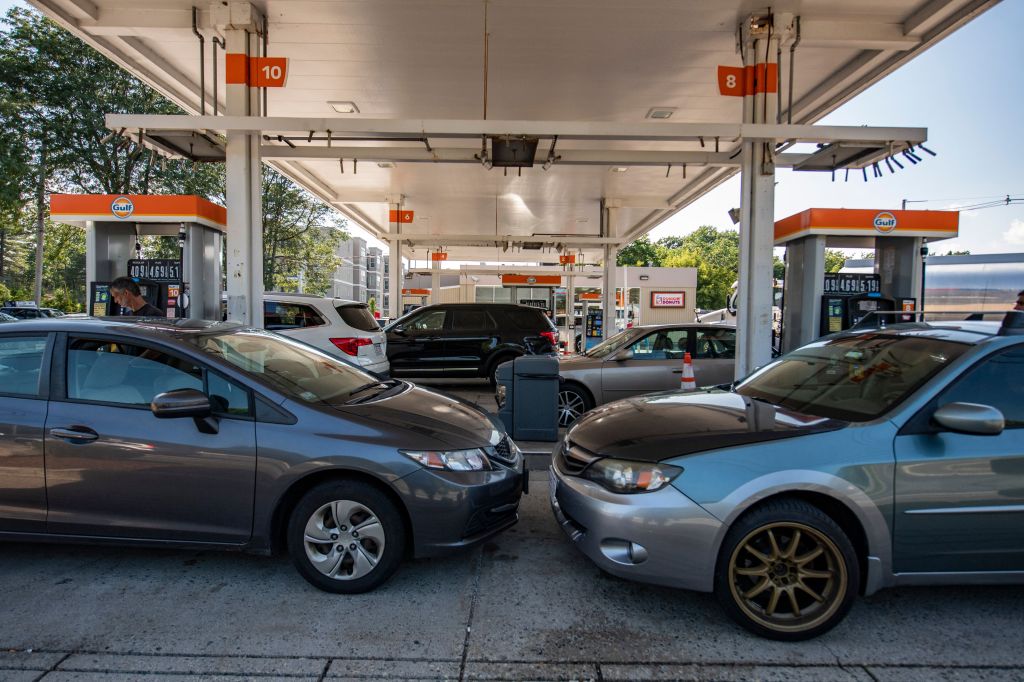During World War II, American auto manufacturers played a major role in assembling the famed “Arsenal of Democracy” that helped defeat the Nazis. This arsenal included tens of thousands of tanks called the M4, more popularly known as Shermans. After the war, auto manufacturers went back to building cars for the families that won the war. Over the ensuing decades, those cars have gotten gradually larger. Today, those pickup trucks and SUVs, which account for the majority of vehicles sold in the U.S. and intended to peacefully transport families and loved ones, are almost as big as the tanks they used to build.
This analysis was inspired by Andy Arthur, a graphic designer and illustrator in Edinburgh, who did a similar comparison with some of the larger vehicles for sale in his home country.
Videos by VICE
But, Arthur told Motherboard in an email he is not familiar with the North American car market, so he concentrated on models available in the UK instead. Here in the U.S., pickup trucks dominate the country’s best-selling vehicle lists year after year. The top three models alone account for about 13 percent of all vehicles sold. And SUVs outsell sedans two to one. The popularity of bigger vehicles is a major cause of rising pedestrian and cyclist deaths.
But, these statistics aside, it can be hard to contextualize just how unusual it is for everyday people to be driving such huge vehicles. To many Americans, bigger vehicles almost feel natural, since the trend has been towards larger and larger models every year for the past three decades, even as some new vehicle owners struggle to fit their vehicles in their own garages.
This is why we’ve chosen to compare the size of these vehicles to World War II tanks. To be sure, there are many differences between World War II tanks and pickups. Shermans weighed approximately 10 times as much as your standard pickup, due in large part to its huge gun and thick armor. They also were not capable of accelerating anywhere near as quickly as modern pickups and SUVs, and World War II tanks could barely go faster than 30 miles per hour.
We also understand there are many, many different types of tanks used in World War II, with many variations and modifications to fit specific purposes (again, not unlike modern cars, which have various “trims” at different price points modifying the same basic design). To keep things as simple as possible, we’ve chosen three of the most prominent tanks deployed in World War II: The American M4 Sherman, the German Panzer Mk III, and the Soviet T-34-85 (1944 production model), all of which are “Medium” tanks. All dimensions for those tanks come from Tanks Encyclopedia and are the vehicle dimensions not including the main gun.
We then compared those lengths, widths (without mirrors), and heights with top-selling light duty pickup and large SUV models as listed on their respective manufacturer websites. (We did not include heavy duty pickups, which tend to be used for commercial purposes.) Here are the results:

As you can see, the most startling result is that there isn’t a huge difference. Generally speaking, pickup trucks in the U.S. are about the same length as a Sherman tank, give or take a few inches, and less than two feet narrower. The biggest difference is in height. The Sherman was 108 inches tall, whereas trucks tend to have a cab height of about 76 inches. (Nearly all pickup trucks in the same class have virtually identical dimensions regardless of which company makes them.) The Panzer and T-34 were shorter than the Sherman both in length and height, but wider.
Perhaps more surprising is that large SUVs like the Chevy Suburban, Lincoln Navigator, and Ford Expedition, specifically marketed as family vehicles, are just as comparable to World War II tanks in size.
Then again, perhaps it’s not surprising. “It’s like driving a tank” is a phrase often used in reviews for these vehicles in a positive way. Large vehicles, especially American pickup trucks, are routinely advertised with military lingo and allusions like “military-grade aluminum alloy,” an intentional marketing technique writer and planning consultant Angie Schmitt has covered. And as Arthur pointed out, car companies often brand their vehicles with militaristic names “such as the Defender, Grenadier, Shogun, Barbarian, Ranger, Warrior, Lancer.”
Still, the degree to which American vehicles are now literally comparable in size to actual tanks is a fact that, like so much else in American life, is celebrated by some and condemned by others. The danger such huge vehicles pose to both other drivers, non-drivers, and the environment are well-documented. But people buy these expensive, impractical vehicles nonetheless, in huge numbers—not in spite of the fact they are basically tanks, but because of it.
“I think it says a lot of people just don’t care so long as they feel they/their family are ‘protected’ and hang the others,” Arthur told Motherboard. “And much like tanks got ever bigger and heavier and more powerful to protect their occupants from other tanks, so SUVs are doing exactly the same.”




